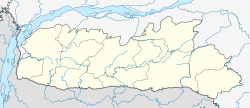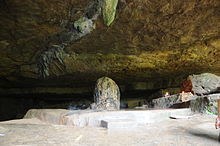Town in Meghalaya, India
| Mawsynram | |
|---|---|
| Town | |
  | |
| Coordinates: 25°17′56″N 91°34′53″E / 25.29889°N 91.58139°E / 25.29889; 91.58139 | |
| Country | |
| State | Meghalaya |
| District | East Khasi Hills |
| Talukas | Mawsynram C.D. Block |
| Area | |
| • Total | 2,788 km (1,076 sq mi) |
| Languages | |
| • Official | English, Khasi |
| Time zone | UTC+5:30 (IST) |
| PIN | 793113 |
| Telephone code | 03673 |
| Vehicle registration | ML |
| Nearest city | Shillong |
| Climate | Cwb |
Mawsynram (/ˈmɔːsɪnˌrʌm/) is a town in the East Khasi Hills district of Meghalaya state in Northeastern India, 69 kilometres from Shillong, the state capital. Mawsynram receives the highest rainfall in India. It is reportedly the wettest place on Earth, with an average annual rainfall of 11,872 millimetres (467.4 in). According to the Guinness Book of World Records, Mawsynram received 26,000 millimetres (1,000 in) of rainfall in 1985. Mawsynram received 745.2 mm of rainfall on 19 August 2015, probably the highest rainfall received by the town in recent times. On 17 June 2022, Mawsynram set a new record by receiving 1003.6 mm in a span of 24 hours which has now become its highest single day record for the month of June and for its all-time single day record, beating its former record of 944.7 mm on 7 June 1966.
Location
| Mawsynram | ||||||||||||||||||||||||||||||||||||||||||||||||||||||||||||
|---|---|---|---|---|---|---|---|---|---|---|---|---|---|---|---|---|---|---|---|---|---|---|---|---|---|---|---|---|---|---|---|---|---|---|---|---|---|---|---|---|---|---|---|---|---|---|---|---|---|---|---|---|---|---|---|---|---|---|---|---|
| Climate chart (explanation) | ||||||||||||||||||||||||||||||||||||||||||||||||||||||||||||
| ||||||||||||||||||||||||||||||||||||||||||||||||||||||||||||
| ||||||||||||||||||||||||||||||||||||||||||||||||||||||||||||
Mawsynram is located at 25° 18′ N, 91° 35′ E, at an altitude of about 1,400 meters (4,600 ft), 15 km west of Cherrapunji, in the Khasi Hills in the state of Meghalaya (India).
Climate and rainfall
Under the Köppen climate classification, Mawsynram features a subtropical highland climate (Cwb) with an extraordinarily showery, rainy and long monsoonal season and a short dry season. Based on the data of a recent few decades, it appears to be the wettest place in the world, or the place with the highest average annual rainfall. Mawsynram receives over 10,000 millimetres or 390 inches of rain in an average year, and the vast majority of the rain it gets falls during the monsoon months. A comparison of rainfalls for Cherrapunji and Mawsynram for some years is given in Table 1. Mawsynram receives the highest rainfall in India. Although it is reportedly the wettest place on Earth, with an average annual rainfall of 11,872 millimetres (467.4 in), this claim is disputed by Lloró, Colombia, which reported an average yearly rainfall of 12,717 millimetres (500.7 in) between 1952 and 1989 and López de Micay, also in Colombia, which reported 12,892 millimetres (507.6 in) per year between 1960 and 2012. According to the records observed by the Indian Meteorological Department, it was seen that while its neighbour, Cherrapunji is having a significant decreasing trend in rainfall, Mawsynram on the other hand is experiencing a slight increase in its rainfall pattern which put its average annual rainfall from 1950 to 2000 at 12,393 millimetres (487.9 in) and from 2000 to 2020 at 12,120 millimetres (477.2 in). The precipitation table below shows the average monthly record from 1950 to 2000.
| Climate data for Mawsynram | |||||||||||||
|---|---|---|---|---|---|---|---|---|---|---|---|---|---|
| Month | Jan | Feb | Mar | Apr | May | Jun | Jul | Aug | Sep | Oct | Nov | Dec | Year |
| Mean daily maximum °C (°F) | 15.5 (59.9) |
16.8 (62.2) |
20.7 (69.3) |
22.1 (71.8) |
22.5 (72.5) |
22.3 (72.1) |
22.4 (72.3) |
22.9 (73.2) |
22.8 (73.0) |
22.0 (71.6) |
19.2 (66.6) |
16.6 (61.9) |
20.5 (68.9) |
| Daily mean °C (°F) | 11.2 (52.2) |
12.8 (55.0) |
16.5 (61.7) |
18.4 (65.1) |
19.2 (66.6) |
19.9 (67.8) |
20.2 (68.4) |
20.4 (68.7) |
20.3 (68.5) |
18.6 (65.5) |
15.2 (59.4) |
12.3 (54.1) |
17.1 (62.8) |
| Mean daily minimum °C (°F) | 6.9 (44.4) |
8.8 (47.8) |
12.3 (54.1) |
14.7 (58.5) |
15.9 (60.6) |
17.5 (63.5) |
18.0 (64.4) |
18.0 (64.4) |
17.8 (64.0) |
15.3 (59.5) |
11.2 (52.2) |
8.0 (46.4) |
13.7 (56.7) |
| Average precipitation mm (inches) | 19 (0.7) |
25 (1.0) |
198 (7.8) |
490 (19.3) |
1,436 (56.5) |
3,162 (124.5) |
3,300 (129.9) |
2,330 (91.7) |
1,050 (41.3) |
331 (13.0) |
48 (1.9) |
4 (0.2) |
12,393 (487.9) |
| Source: (year rain) | |||||||||||||
Primarily due to the high altitude, it seldom gets truly hot in Mawsynram. Average monthly temperatures range from around 11 °C (51.8 °F) in January to just above 20 °C (68 °F) in August. The village also experiences a brief but noticeably drier season from December until February, when monthly precipitation on average does not exceed 30 millimetres (1.2 in). The little precipitation during the village's "low sun" season is something that is shared by many areas with this type of climate.
The following table is a comparison of rainfalls for Cherrapunji and Mawsynram between 1970 and 2010.
| Year | Cherrapunji Rainfall (mm) | Mawsynram Rainfall (mm) |
|---|---|---|
| 2010 | 13 472 | 14 234 |
| 2009 | 9 070 | 12 459 |
| 2008 | 11 415 | 12 670 |
| 2007 | 12 647 | 13 302 |
| 2006 | 8 734 | 8 082 |
| 2005 | 9 758 | 10 072 |
| 2004 | 14 791 | 14 026 |
| 2003 | 10 499 | 11 767 |
| 2002 | 12 262 | 11 118 |
| 2001 | 9 071 | 10 765 |
| 2000 | 11 221 | 13 561 |
| 1999 | 12 503 | 13 445 |
| 1998 | 14 536 | 16 720 |
| 1997 | 8 993 | 9 892 |
| 1996 | 12 989 | 12 850 |
| 1995 | 14 189 | 13 832 |
| 1994 | 11 194 | 10 940 |
| 1993 | 12 807 | 13 848 |
| 1992 | 8 537 | 10 450 |
| 1991 | 13 494 | 16 112 |
| 1990 | 11 598 | 12 934 |
| 1989 | 13 432 | 8 828 |
| 1988 | 17 948 | 16 750 |
| 1987 | 13 153 | NA |
| 1986 | 8 140 | NA |
| 1985 | 11 816 | 26 000 |
| 1984 | 16 761 | 25 613 |
| 1983 | 9 773 | 12 163 |
| 1982 | 10 468 | 9 246 |
| 1981 | 9 113 | 9 739 |
| 1980 | 9 133 | 9 739 |
| 1979 | 12 095 | NA |
| 1978 | 6 950 | NA |
| 1977 | 11 689 | 11 986 |
| 1976 | 11 012 | 6 134 |
| 1975 | 11 976 | 10 639 |
| 1974 | 24 554 | NA |
| 1973 | 10 911 | NA |
| 1972 | 11 095 | NA |
| 1971 | 16 915 | NA |
| 1970 | 15 318 | NA |
Source:

Three reasons can be cited for high rainfall at Mawsynram:
- The warm moist winds of the northward-moving air from the Bay of Bengal during the monsoon, which cover an extensive area but are forced to converge into the narrower zone over the Khasi Hills, thus concentrating their moisture.
- The alignment of the Khasi Hills (east to west) places them directly in the path of the airflow from the Bay of Bengal, producing a significant uplift (plus cooling, further condensation and thus more rain).
- Finally, uplift over the Khasi Hills is virtually continuous in the monsoon period because the lifted air is constantly being pulled up by vigorous winds in the upper atmosphere; hence, the rainfall is more or less continuous.
Natural landmarks
Located in Mawsynram, is a cave named Mawjymbuin, known for its stalagmites. Inside this cave is a pair of notable speleothems - stalactites shaped like a cow's udder over a large stalagmite. The area is known for its many caves, both commercialized and non-commercialized.
References
- ^ "Global Weather & Climate Extremes". Arizona State University World Meteorological Organization. Archived from the original on 8 December 2015. Retrieved 22 July 2015.
- ^ "Meghalaya: The Wettest Place on Earth". The Atlantic. 22 August 2014. Archived from the original on 7 January 2015. Retrieved 23 August 2014.
- "Mawsynram, India". National Geographic. 4 February 2013. Archived from the original on 5 October 2017. Retrieved 23 August 2014.
- "Know about Mawsynram in Meghalaya which witnessed the world's highest rainfall". DNA India. Retrieved 3 December 2023.
- Das, Manosh (21 August 2015). "Mawsynram rains on Sohra parade, again". The Times of India. Archived from the original on 18 August 2021. Retrieved 18 August 2021.
- Kuttippurath, J; Murasingh, S; Stott, P A; Sarojini, B Balan; Jha, Madan K; Kumar, P; Nair, P J; Varikoden, H; Raj, S; Francis, P A; Pandey, P C (22 January 2021). "Observed rainfall changes in the past century (1901–2019) over the wettest place on Earth". Environmental Research Letters. 16 (2): 024018. Bibcode:2021ERL....16b4018K. doi:10.1088/1748-9326/abcf78. ISSN 1748-9326.
- The Tribune, Chandigarh, August 2003.
- "Mawsynram climate". Climate-data.org. Archived from the original on 28 March 2019. Retrieved 3 March 2020.
- Handbook 1975 Archived 5 November 2018 at the Wayback Machine megplanning.gov.in
- "Statistical Handbook" (PDF). megplanning.gov.in. 1978. Archived (PDF) from the original on 5 November 2018. Retrieved 19 April 2016.
- Handbook 1984 Archived 5 November 2018 at the Wayback Machine megplanning.gov.in
- Handbook 1987 Archived 5 November 2018 at the Wayback Machine megplanning.gov.in
- Handbook 1995 Archived 5 November 2018 at the Wayback Machine megplanning.gov.in
- Handbook 1998 Archived 5 November 2018 at the Wayback Machine megplanning.gov.in
- Handbook 1992 Archived 5 November 2018 at the Wayback Machine megplanning.gov.in
- Handbook 2008 Archived 5 November 2018 at the Wayback Machine megplanning.gov.in
- "Rainfall Chart | Cherrapunjee". Archived from the original on 11 June 2015.
- The Scotland of the East! Archived 29 November 2014 at the Wayback Machine The Hindu, October 15, 2007
- "Khasi Hills: Mawsynram". Department of Tourism, Government of Meghalaya. Archived from the original on 8 August 2018. Retrieved 23 August 2014.
- Middleton, Nick. Going to Extremes. Pan, 2012.